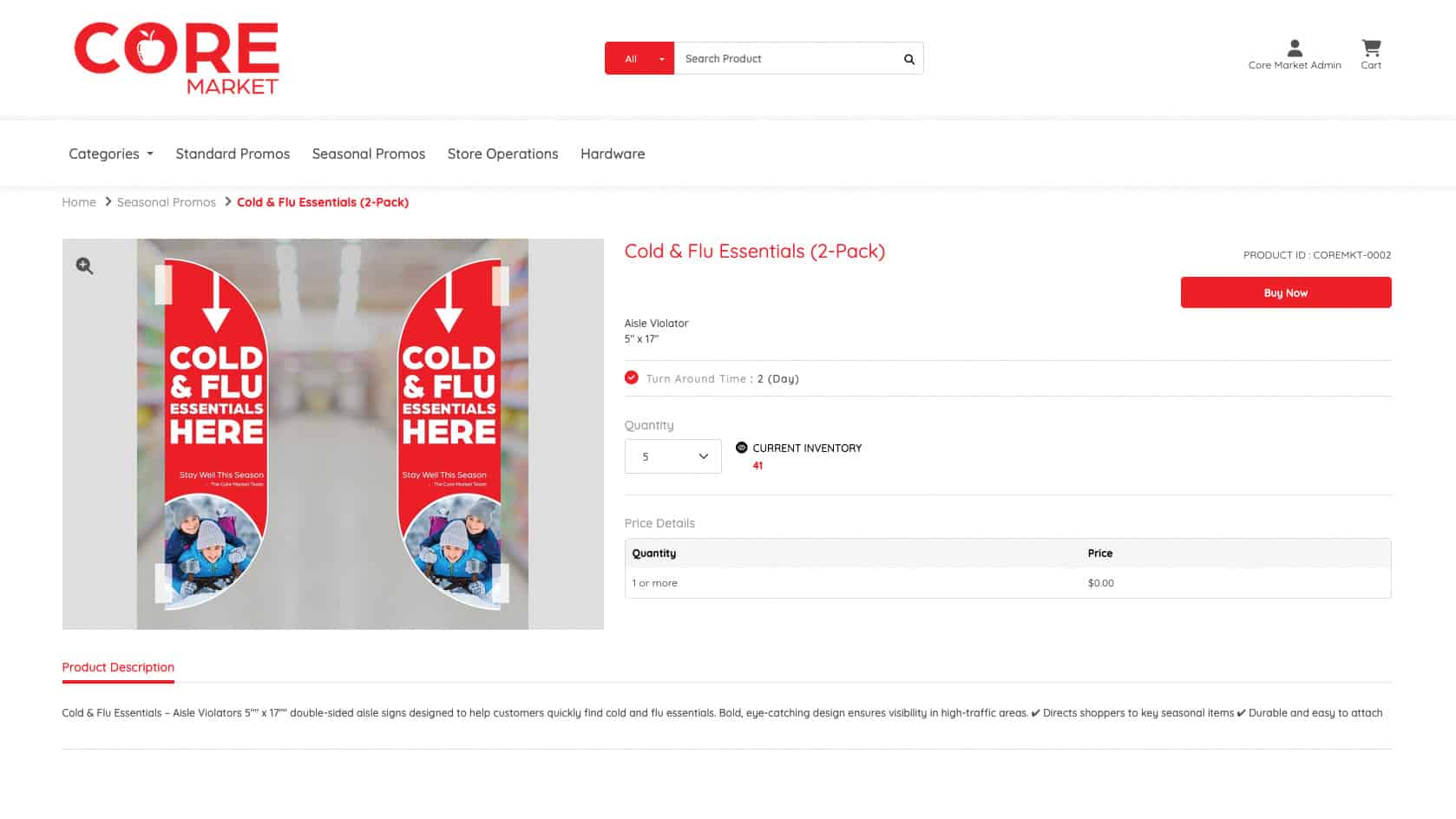
Menu
Menu
“Offline communication”—whether you call it signage, retail graphics, large format print or ISM, over the past 10 years I’ve worked on it with global brands—and ones that are just getting started.
There are several major brick and mortar growth stages, each with their own challenges. It all really begins when napkin sketches and spreadsheets become a flagship store. For leaders with growth in mind, flagship stores are prototypes—tests that validate the next step. (Phase 1, no special name.)
With proof your model works, the next handful of locations sprout up. They’re tests too. From refining insights to growing teams and adding the tools and processes needed to keep a few locations humming, there’s a lot of foundation setting going on. It’s herding cats, but once you’ve got them marching in single file, it’s time for the real test: scaling your operations and brand into retail domination and the cover of Fast Company.
Okay—scaling! You’ve reached Phase 2, which is my favorite. I even have a name for it: “Branch & Soar!”


This is an exciting chapter for a retailer—whether you’re selling a dining experience, float isolation, escape room adventures, picture frames or clothes—the way you’re doing it is working.
Often—maybe always, a key diver is differentiation. How you’re doing it is different in ways your customers prefer. It’s earning you referrals, your brand is spreading and your team is energized.
This begs the question, “What ARE you doing differently?” For retailers, this is certainly a mix of many things, but fundamentally, you’ve created a superior client experience. And that stems from tangible effort and investments you’re putting into that experience.
At smaller scales, it’s relatively easy to manage all these experience differentiators. Your stores are unique—from how they’re decorated/merchandised to how your team interacts with guests, how they follow up…lots of factors. You’ve discovered how much the little things matter.
I’ve seen (and supported) experience tactics that are undeniably “extra”—like store associates sending handwritten thank you cards to clients. Offering premium, reusable (and branded) shopping bags for free—bags their guests enjoy being seen carrying, and probably would have paid for. …Elaborate handcrafted merchandising and inventory resets that cycle much faster than their competition. Community engagement efforts, social missions, omnichannel advertising campaigns—the marketing backend that’s needed to drive awareness and first time visits extends into great in-store experiences and beyond to unlock a different type of growth.
These marketing and store operations efforts break through rational thinking to resonate with guests in a different way. Expectations are exceeded, emotional connections are formed—loyalty is earned and advocacy is won. The growth curve starts climbing, fast.
The tactics that drove that early success took work. There’s always at least one magical unicorn superstar that’s at the center of all this. That person and the team around them manage, coordinate, ship, replenish, replace, innovate, curate, inspect and deliver. But, as business heats up and 5 locations become 8, then 12, it starts to get increasingly difficult to keep it all flowing. It becomes additional full-time jobs, and magical unicorns are kind of like lightning—it’s rare to get two on one team. I’ve seen this in literally every transition from small to medium size retailer I’ve worked with. The systems and approaches that worked before start to break down and become less efficient.
It’s a bit counterintuitive, but costs don’t just inherently decrease with scale. What it takes to manage the experience in 5 stores can actually get harder, in non-linear ways, when you get to 10. Realizing the efficiencies of scale requires changes in how you’re managing all those experience differentiators that are working. That’s the barrier. That’s the challenge and it can grind away momentum. In a recent partnership, heroic efforts by five client-side employees (all unicorns) were keeping their superior experience engine running. Their struggles behind the scenes made it clear that they needed a better approach. And to their credit, they acted on it. …It’s how Thysse and I got involved.
Let me first say, implementing “better approaches” isn’t easy—but it’s worth it. At face value, it often seems like it should be fairly straightforward, but as we dig into the details and begin mapping out the steps, the scope of the project reveals itself. It’s a barrier that trips up some growing retailers. One good look at it and there can be a rational response that tries to bypass, bruit force or just skip clearing it. But, as I like to advise, it will never be easier to make changes in the future.
It’s an interface challenge. It’s essentially figuring out how to connect all the pieces that make up that winning guest experience so that everything from artwork, approvals, orders, shipments, inventory levels, reporting, notifications and payments can flow between the retailer and, in this case, us in much more efficient, reliable and automated ways. Dense chunk of text there, but that’s as concise as I can make it.

There are plenty of platforms that can do some of this within a narrow set of assets and with limitations that may seem manageable. But, there simply isn’t an off-the-shelf tool that can accommodate a diverse set of assets, logistics requirements—and your process/workflow needs—and do it well.
In the case of the client above, the process took about a year to complete. There were plenty of short-term improvements along the way—so it’s not like it’s just a struggle for a year and then utopia. It’s gradual. But, at the end of the project, three of the five full-time employees were able to shift their efforts back to support the growth mission in more valuable ways. The timing was perfect. This retailer will almost double, adding 20 new locations in the next 12 months.
The highly customized system we developed now manages virtually every asset each location needs. From new store buildout kits (delivered by freight), to totes, signs, graphics and business cards—new or replacements, it’s all a couple of clicks away.
We refer to these custom asset management solutions as “brand portals”, and that’s really what they are. From fully centralized to completely decentralized models with custom permissions and reporting, inventory management and print-on-demand—they’re powerful growth catalysts in many ways.
It’s incredibly gratifying to stand these solutions up and get client reactions. It’s kind of like moving your accounting team from graph paper to Excel. They’re literally delighted and can’t imagine how they ever did it any other way.
It’s not just a more scalable and reliable approach—it cuts costs and improves brand management. On costs, direct-to-store fulfillment eliminates extra legs of shipping and handling. It cut the manpower needed to manage this aspect of store operations. For this client, it enabled them to drive asset costs down 15%. And, that’s on top of the logistics and management cost savings—plus, it’s faster. Items now reach stores in days instead of weeks.
Brand standards management and the value of it isn’t always appreciated up front—but its value tends to get tangible after a few months. Whether you’re using a decentralized model that enables your stores to order what they need, or you’d rather control all asset shipments—or a hybrid—brand asset creation and approvals can remain centralized. If you’re not a Pantone Patroller on your squad, those that are will appreciate this.

I’ll just briefly touch on Phase 3. I wasn’t going to—but here we are.
To be fair, there are lots of growing pains that need to be managed well to scale. And while accounting, human resources, business management and leadership structure aren’t things Thysse can help (much) with, once you’re good at adding and supporting new and existing locations, the game shifts. You’ve got an album of hits, and your fans just want you to keep singing them. It’s about consistency.
You don’t reach Phase 3 without clearing the logistics barriers in Phase 2, so at this point, you’ve got the process figured out, you just need all systems to work reliably. The word “durable” jumps out at me when I’m working on Phase 3 projects. On my provider side, I’m looking for ways I can ensure retail operations keep humming. The world is entropic. Things happen. Maybe there’s a trade war—or several. Maybe there’s a shipping strike. Maybe a ship gets stuck in the Panama Canal, or maybe your design files get approved a week later than we planned. Durable systems take the hit and deliver on time and at standard.
The game becomes rinse, recycle and repeat. …A playbook that leverages the scalable systems you’ve put in place, where adding locations doesn’t fundamentally change what it takes to manage/support them. You’ve built a scalable system and it’ll spin as fast as you’d like it to.
That’s the fun part for us. Thysse’s culture is all about relationships and partners. Your success is ours, and it’s thrilling to be a part of these journeys.
And they are journeys. Mid-stream, it can feel like a daunting trek and like you’re making all the mistakes. But you’re not. This is how it feels for every passionate, overworked unicorn. In fact, after reassuring a client this morning she responded: “Really?! It’s not just us?! I always feel like we’re the worst client!” …No, you aren’t. This is normal and it’s going to be great.